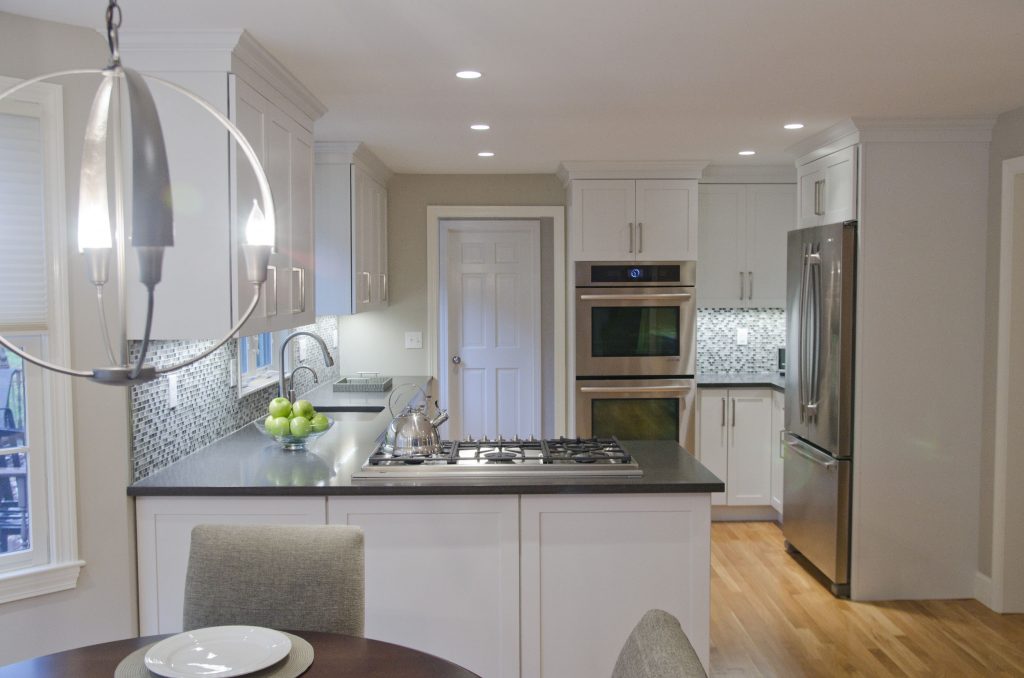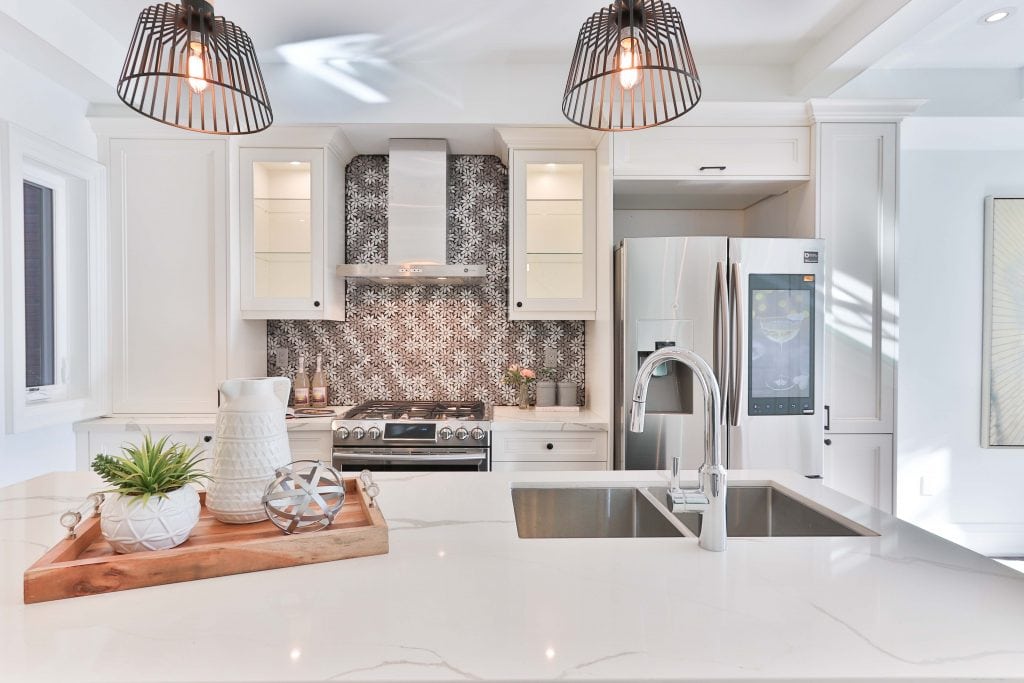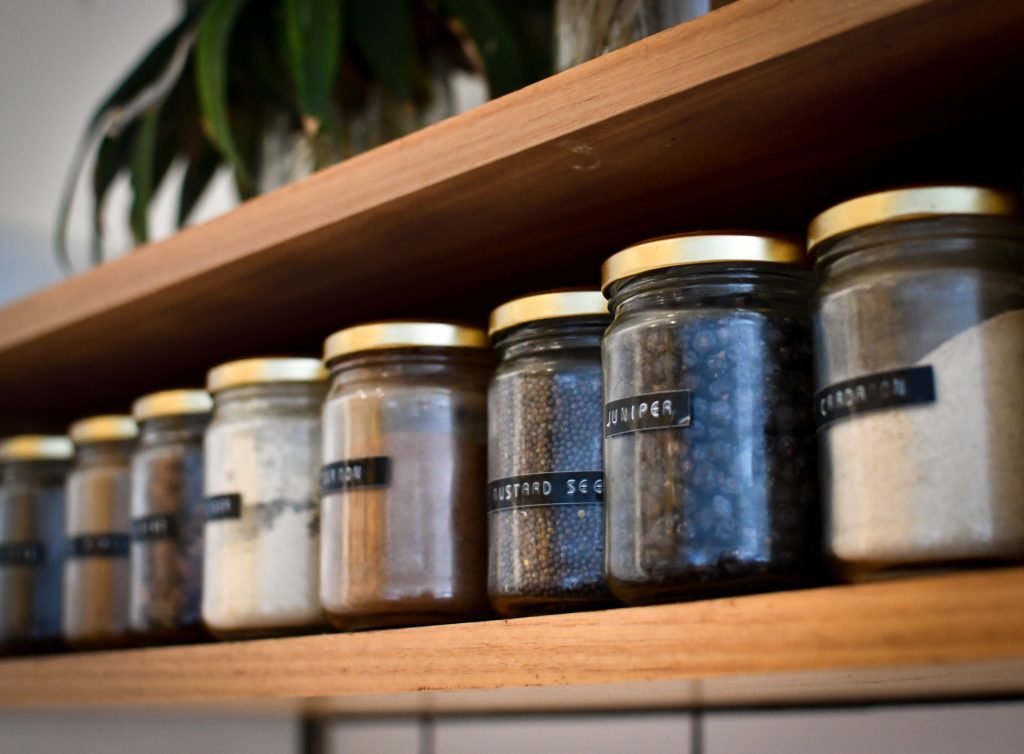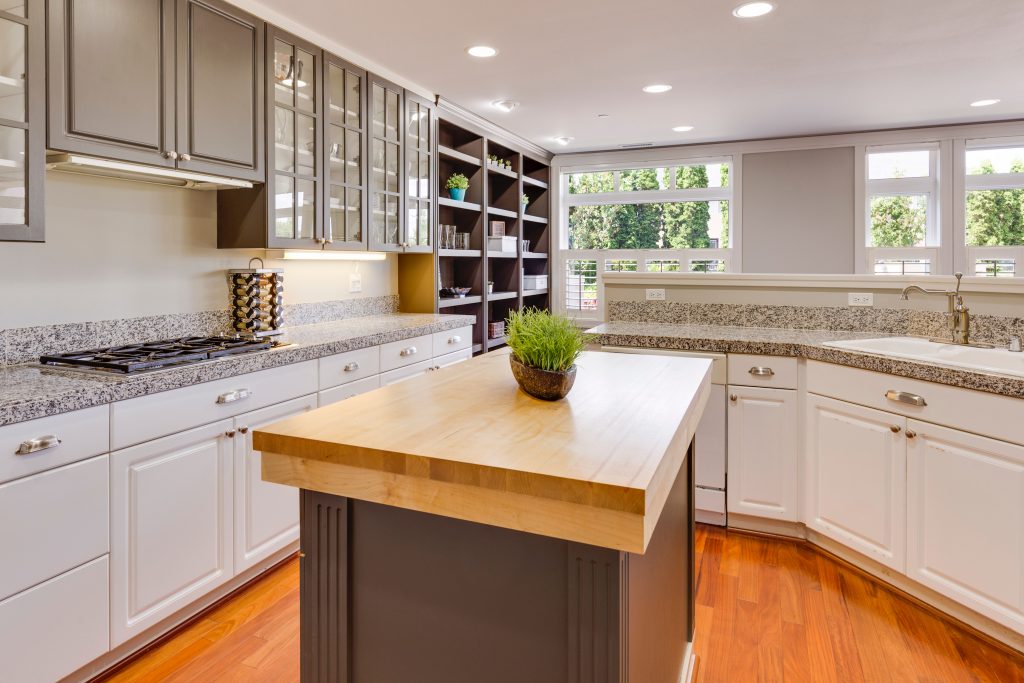You hear the cheerful clinking sound of glasses, the atmosphere is warm and inviting—a soft glow surrounds you, you are comfortably sitting on a sumptuous barstool, resting your elbows on the beautiful landscape of swirling veins and colorful movement revealed in the polished quartzite countertop. You glance at the pleasing proportions, details and contours of the cabinetry and architecture around you. You feel like you are at the beautiful bar area of your favorite restaurant, but you are not…Where are you?

You are enjoying your own, private, perfect DREAM kitchen! You could never have imagined you could “have it all”, but with the expert guidance, insight and creative direction of your favorite interior designer, you have achieved the kind of “heart of the home” kitchen you could only have imagined in the far flung corners of your imagination. You consider the nightmare your next door neighbors endured trying to finalize every design decision from the important, fundamental layout and space planning challenges to finalizing decisions around cabinet style and color, lighting fixtures, back splash tile, countertop material and hardware. They knew you had infinite and endless choices and decisions to make, and had no idea where to start. And then, once they had agonized over all their final selections, they still didn’t really know how all those elements would look together. Would the kitchen even function well, never mind look great?
There is also the matter of the contractor—who can you trust to build YOUR dream kitchen. How will you save yourself from costly mistakes and a lack of planning, knowledge and foresight? You may have done a decent job at putting all the “parts and pieces” together, but if the implementation goes wrong, what is your recourse?
By hiring an expert, who has somehow found a way to (seemingly) read your mind, as well as having the experience and that key, trusted team of vendors, contractors and sub-contractors that is your dream team! You have your “one stop shop” answer to your kitchen renovation dilemma. You know that everyone loves congregating in the kitchen, so making this area of your home a truly comfortable and beautiful haven is never a bad idea! However, planning a stunning, well-functioning kitchen is not a simple or inexpensive proposition, so why not buy yourself a little insurance??
Here are the top 10 design pitfalls and planning mistakes that a qualified, experienced designer can help you prevent:
1. Lack of Countertops:
You may be so excited to add that new “food preservation column”, newest take on the appliance garage, or other built-in elements, that you forget your prep and “landing space.” Whether it is for dinner prep, bread making, or your landing space for loading groceries into the refrigerator and pantry, adequate and well planned countertop space is essential.
2. A poorly laid out work flow: The GOLDEN TRIANGLE

In kitchen design, the “golden triangle” is the work flow and ease of motion between your sink, refrigerator and stove. For a kitchen to function comfortably and efficiently, the access and unobstructed flow between these three areas is very important. Not only should the traffic flow be open and easy, but keep number of steps in mind, as well. Some kitchens are huge, but a well-planned one will still have these three key “task” areas nicely adjacent to one another.
3. Island Crazy:
No one loves a big, beautiful, well-crafted island better than I do, but don’t let you “island” love obscure the fact that not every kitchen space can accommodate an island feature. If you have a natural galley kitchen layout, or a small space, trying to force the inclusion of an island can be a huge mistake—resulting in narrow “alleyways” and impossibly tight flow patterns. Ultimately, you will be happier with your kitchen if the design is well aligned to using the available space in the best, most effective way possible. A narrow kitchen footprint, for example, may work much better with an L-shaped layout (with a “peninsula” element, rather than a separate island.) Alternatively, a smaller, roll-away, multi-tiered work table or kitchen “cart” than can be tucked away when not in use can be a great solution in a smaller kitchen.
4. No Room for Storage:

Design 101: Remember the “form follows function” rule in design. A design or architectural feature is, ultimately, no good if it doesn’t serve its function well. For example, in a kitchen that requires a lot of storage for utensils, large pots and pans, platters, and endless glassware, open shelves may not be a great idea. Most people neither can or desire keeping their kitchen immaculate at every moment, which means that most of us want storage solutions that not only amply accommodate, but nicely hide away all our cool kitchen tools and gagets. On the other hand, if you have a tidy, small kitchen requiring ease of reach and everything well in site, open shelves to house and display your cute ceramic bowls and mugs might be the perfect choice. When planning your kitchen cabinetry, it’s a great idea to first do an inventory of all your kitchen tools, pots and pans, small appliances, cook books, and whatever else requires storage (either open or closed.) This is also an opportune time to de-clutter and eliminate extra stuff that you either never use or no longer need.
5. Lighting Brilliance, or NOT?:
Multi-layered, specific function, and meticulously thought out lighting is one of the Keys to creating a kitchen where you never want to leave. If you have an island, or any kind of seating area or special feature, give your kitchen the beautiful focal point (and the good lighting) the area deserves. Pendant or chandelier (special “feature”) lighting not only provides wonderful ambiance, but is a great opportunity to add some extra sparkle and personality to your kitchen design. Ambient lighting, however, is equally important to making the overall lighting even and inviting. Smaller (3” and 4”) recessed LED lights will give you a lovely quality of light while being visually discreet—not drawing too much attention to the ceiling plane. Finally, don’t forget the important of well-place and good quality task lights, such as your under cabinet lights. These days, many manufacturers make thin (3/4”-1”) under cabinet lights that can be easily mounted and hidden under the upper cabinets. Many versions also include a temperature control “toggle” switch, so you can choose a warmer (usually 2700 K) to slightly cooler light to change the feeling of the light highlighting your countertops and work areas. Quality and positioning of lighting is HUGE in terms of creating the right atmosphere in your favorite space, so seek professional guidance. This is not a place to “skimp” on your kitchen design.
6. Stay on Track, Not on Trend
Your new kitchen should be an inviting and inspired place, but don’t get carried away by every latest trend or state-of-the-art appliance. At any moment in time, there may be trends toward materials or finishes, or even styles of cooking and gathering that may seem exciting and tempting to follow, but may very well not stand the test of time. Think about those mirrored tile back splash mosaics, or the shiny apple green or brick red laminated cabinets, or the arched top yellow oak cabinets that dominated in kitchen cabinetry design throughout the 80’s…Most of the time, you cannot go (too far) wrong if you stick to natural materials. You can still have fun with the “latest and greatest” of new design ideas, but keeping things a bit more classic and sticking with wood, glass, ceramics, porcelain and natural stone will never be a bad idea.
7. Relationships are Important:
Solid kitchen design, as we have noted, has a lot to do with good planning, thinking through patterns of usage and functional requirements, and investing in good quality materials. Other “make or break” aspects of good design, however, are proportion, scale and visual balance. Think how visually pleasing a unbroken column of tall cabinetry looks when “flanked” or balanced by open countertop areas on either side, or how harmonious it looks to “bookend” tall elements (i.e a tall refrigerator on one end and a tall china or pantry cabinet on the other, when designing a wall of a kitchen. Keeping your “golden triangle” in mind, pay attention to breaking up the “highs and lows” of your cabinetry (and/or open shelving. Lay out your cabinetry so that visually open areas are nicely balanced out by more visually solid or visually “dense” elements of your kitchen. This “rule” should also be applied to your details as well. For example, if you want more visual depth or interest in the look of your cabinet doors, you may choose a more traditional raised panel or other more architecturally detailed door face. Alternatively, if you have lots of cabinet doors adjacent to one another, a more simple door face style (like a shaker style door) may look better, and not get to visually overwhelming.
8. Focal Points:

It can be tempting to add visual “bells and whistles” to all the different elements in your new kitchen. You may fall in love with a gorgeous, colorful back splash tile from morocco, and then be drawn to the most dynamic and exciting quartzite countertop material—bursting with movement and color. You see the fantastic, blown Murano glass pendants that dazzle your eye whenever you hang out in your best friend’s kitchen. While all of these beautiful, eye-catching materials might be amazing, you don’t necessarily want to put them all together. Why not?? The human eye can take in and process a lot of visual information, but if our visually attention is taken in by too many exciting, contrasting elements all at once, we can lose the ability to appreciate the beauty of individual colors, patterns, or shapes. If your favorite design element is your fabulous marble, granite or quartzite, let that be your main focal point. Highlight the dynamic qualities of the stone by (perhaps) choosing a simple glass pendant light that picks up on of the fabulous colors in the stone. A back splash tile that adds visual interest from visual texture (like a crackle glaze or a mother-of-pear (verses a highly patterned mosaic tile) will allow all the distinct points of visual interest to integrate and harmonize together like the subtle layering of paint on canvas.
9. Invest in the Best:
We all have budgets, and an investment in your “Heart of the Home” is important. Realtors will tell you that investing in a kitchen or bathroom upgrade will always be an excellent way to build instant equity in your home, as these investments usually represent a 100% (or close) ROI. These are spaces people care about, and spend a lot of time enjoying, so it is worth putting the best quality you can afford into your kitchen. Your kitchen budget, ideally, should fall within the range of what is appropriate for the similar house within your neighborhood. While you don’t want to spend a huge amount more than what is appropriate for your particular housing market, you will never go wrong to invest in the following:
High Quality cabinetry: well-made and crafted to stand up to normal kitchen wear and tear. Mortise and tendon joinery, dovetail drawers, solid, full assembled cabinet boxes, high quality cabinet frames with integrated brace construction, soft-close hinges, plywood or solid maple interiors, soft close drawer glides, and catalyzed factory finishes (for the paint and stains) are just a few things to identify and review when buying cabinetry.
Highly rated appliances: When choosing your appliances, it is definitely worth reading consumer reports, and also asking the advice of your local appliance showroom sales’ person. Most appliance sales’ representatives are very knowledgeable, and will know (for example) if a particular brand has had recent service issues, or unresolved issues with parts failures, service history, etc. Do your homework, and you will likely end up with reliable appliances. Keep in mind that appliance pricing can vary widely, so do consider that a well-rated less “fancy” brand may suit your needs just fine. If you are someone who loves cooking, and you are looking for special features, it may be worth investing in the particular range that really can “do it all!”

Solid architectural and decorative lighting: Not all lighting is created equal. Often people wonder, for example, why two pendant fixtures that may look identical are listed at such different price points. Again, this comes down to quality construction and finishes. When buying your kitchen pendants, chandeliers and other decorative lighting, look carefully at the metal finishes and glass. It is a good idea to check out fixtures from a certain manufacturer in person, so that you can really see the look at feel of the finishes. On-line the “antique nickel” finish of one fixture may look very similar to another, but you will be able to see, in person, the differences. Stay away from the metal finishes that look or feel insubstantial or “tinny” in appearance. Good quality fixtures made of solid brass, nickel, or silver will be heavier, but will stand the test of time (and the visual “inspection.”)
10. Seek Advice and Recommendations:
Kitchen installations–with the intricacies of the different lighting requirements, cabinetry installation details, and appliance hook-up needs (to mention only a few aspects of a kitchen renovation)—are complicated. A knowledgeable, highly experienced contractor or installer is truly the only person you want putting your kitchen together. You may have invested in the most beautiful, superior materials and finishes available, but if all these elements are poorly installed, you will have wasted that investment, and saddled yourself with a logistical and financial nightmare. Asking a local interior designer, architect or trusted friend or neighbor for recommendations is invaluable. Most architects and interior designers have, over time, identified several builders and general contractors they trust to always produce great results. Don’t hesitate to ask around!
Finally, try to enjoy the process! Choose elements that you love and that speak to your individual tastes, style and lifestyle, and you WILL be able to create your dream kitchen!
